Economics Assignment: Oligopoly, Monopolistic Competition in Australia
VerifiedAdded on 2021/05/27
|20
|4226
|246
Report
AI Summary
This economics assignment delves into the theoretical frameworks of market structures, focusing on oligopoly and monopolistic competition. It defines these market types, highlighting their key features and differences, such as the number of sellers, market power, barriers to entry, product differentiation, decision-making processes, and levels of competition. The assignment contrasts these structures with perfect competition and analyzes their implications in the Australian context, particularly in the banking sector, which exemplifies oligopolistic characteristics. Furthermore, it explores profit-making possibilities and equilibrium situations in both the short and long run for firms operating within monopolistically competitive and oligopolistic markets, including scenarios involving price wars and cartels. The analysis includes graphical representations to illustrate these concepts, providing a comprehensive understanding of market dynamics.
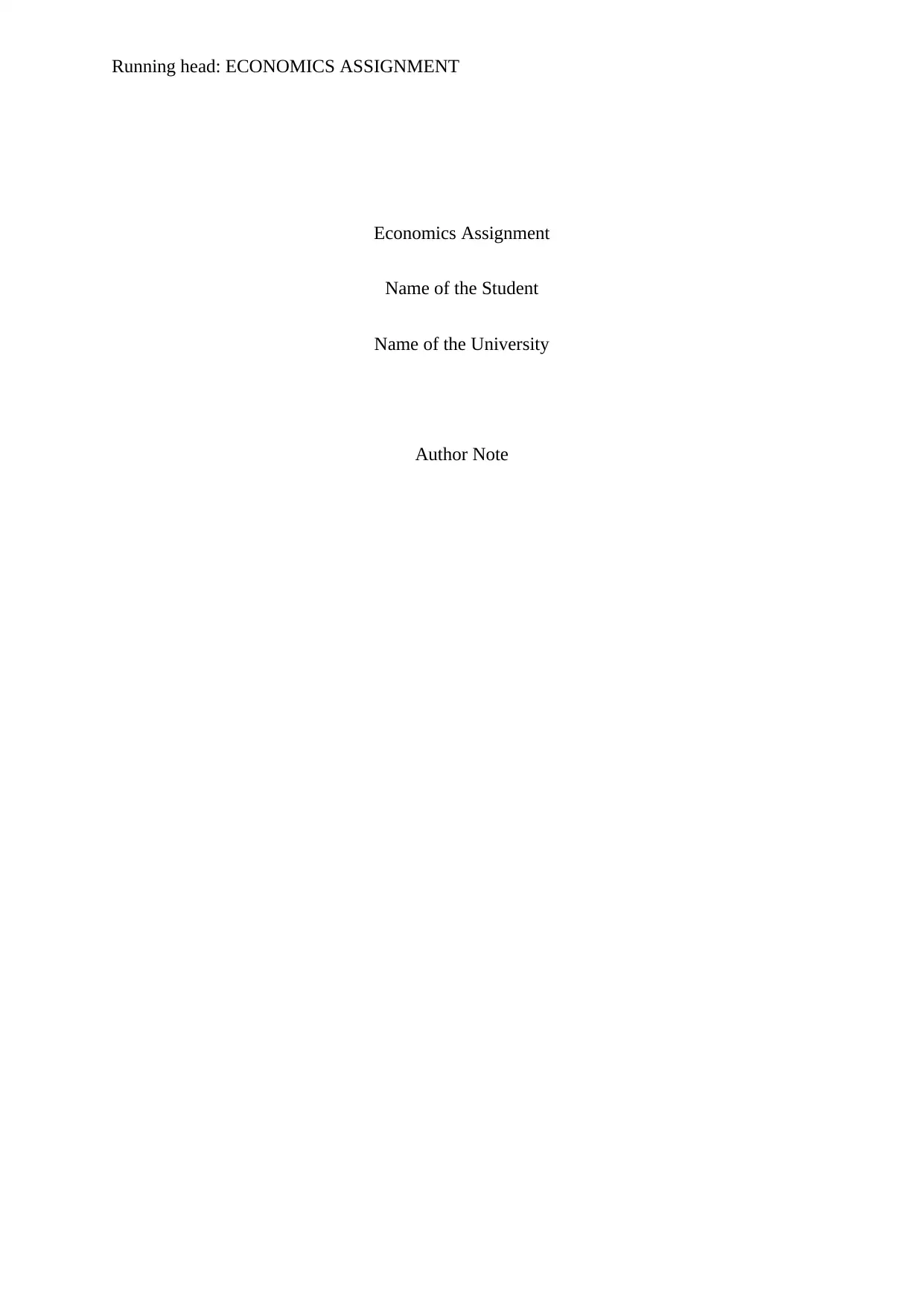
Running head: ECONOMICS ASSIGNMENT
Economics Assignment
Name of the Student
Name of the University
Author Note
Economics Assignment
Name of the Student
Name of the University
Author Note
Paraphrase This Document
Need a fresh take? Get an instant paraphrase of this document with our AI Paraphraser
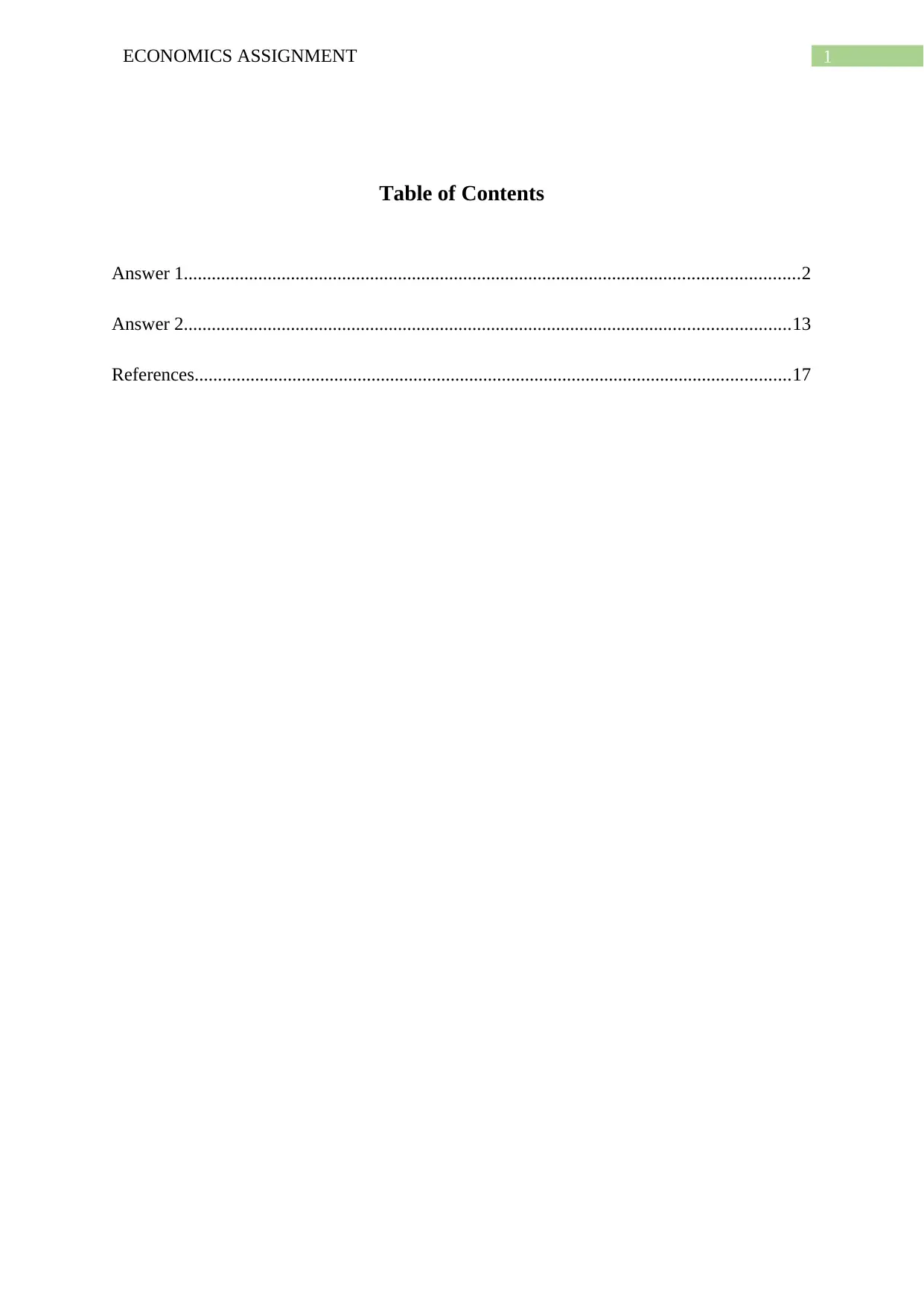
1ECONOMICS ASSIGNMENT
Table of Contents
Answer 1....................................................................................................................................2
Answer 2..................................................................................................................................13
References................................................................................................................................17
Table of Contents
Answer 1....................................................................................................................................2
Answer 2..................................................................................................................................13
References................................................................................................................................17
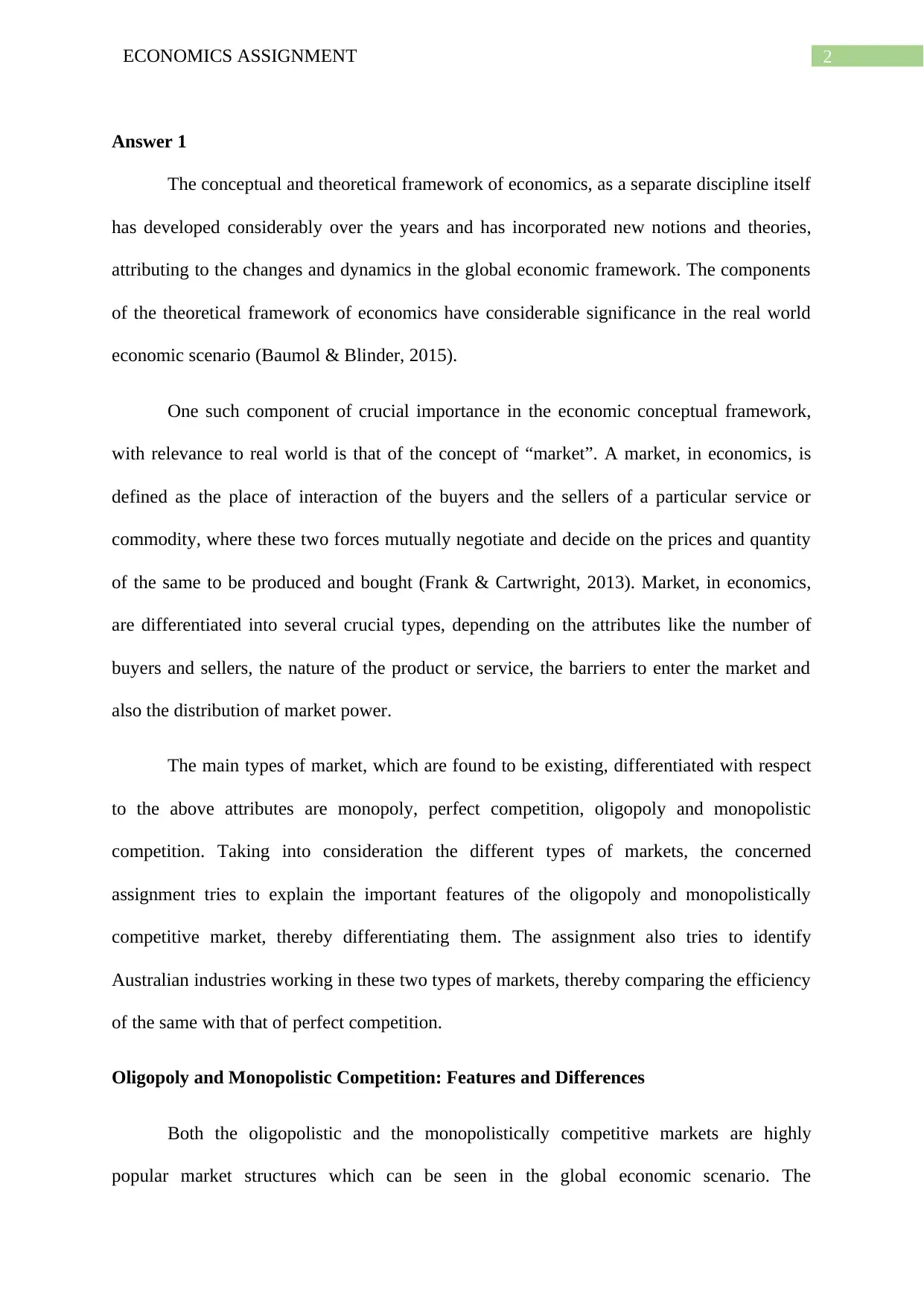
2ECONOMICS ASSIGNMENT
Answer 1
The conceptual and theoretical framework of economics, as a separate discipline itself
has developed considerably over the years and has incorporated new notions and theories,
attributing to the changes and dynamics in the global economic framework. The components
of the theoretical framework of economics have considerable significance in the real world
economic scenario (Baumol & Blinder, 2015).
One such component of crucial importance in the economic conceptual framework,
with relevance to real world is that of the concept of “market”. A market, in economics, is
defined as the place of interaction of the buyers and the sellers of a particular service or
commodity, where these two forces mutually negotiate and decide on the prices and quantity
of the same to be produced and bought (Frank & Cartwright, 2013). Market, in economics,
are differentiated into several crucial types, depending on the attributes like the number of
buyers and sellers, the nature of the product or service, the barriers to enter the market and
also the distribution of market power.
The main types of market, which are found to be existing, differentiated with respect
to the above attributes are monopoly, perfect competition, oligopoly and monopolistic
competition. Taking into consideration the different types of markets, the concerned
assignment tries to explain the important features of the oligopoly and monopolistically
competitive market, thereby differentiating them. The assignment also tries to identify
Australian industries working in these two types of markets, thereby comparing the efficiency
of the same with that of perfect competition.
Oligopoly and Monopolistic Competition: Features and Differences
Both the oligopolistic and the monopolistically competitive markets are highly
popular market structures which can be seen in the global economic scenario. The
Answer 1
The conceptual and theoretical framework of economics, as a separate discipline itself
has developed considerably over the years and has incorporated new notions and theories,
attributing to the changes and dynamics in the global economic framework. The components
of the theoretical framework of economics have considerable significance in the real world
economic scenario (Baumol & Blinder, 2015).
One such component of crucial importance in the economic conceptual framework,
with relevance to real world is that of the concept of “market”. A market, in economics, is
defined as the place of interaction of the buyers and the sellers of a particular service or
commodity, where these two forces mutually negotiate and decide on the prices and quantity
of the same to be produced and bought (Frank & Cartwright, 2013). Market, in economics,
are differentiated into several crucial types, depending on the attributes like the number of
buyers and sellers, the nature of the product or service, the barriers to enter the market and
also the distribution of market power.
The main types of market, which are found to be existing, differentiated with respect
to the above attributes are monopoly, perfect competition, oligopoly and monopolistic
competition. Taking into consideration the different types of markets, the concerned
assignment tries to explain the important features of the oligopoly and monopolistically
competitive market, thereby differentiating them. The assignment also tries to identify
Australian industries working in these two types of markets, thereby comparing the efficiency
of the same with that of perfect competition.
Oligopoly and Monopolistic Competition: Features and Differences
Both the oligopolistic and the monopolistically competitive markets are highly
popular market structures which can be seen in the global economic scenario. The
⊘ This is a preview!⊘
Do you want full access?
Subscribe today to unlock all pages.

Trusted by 1+ million students worldwide
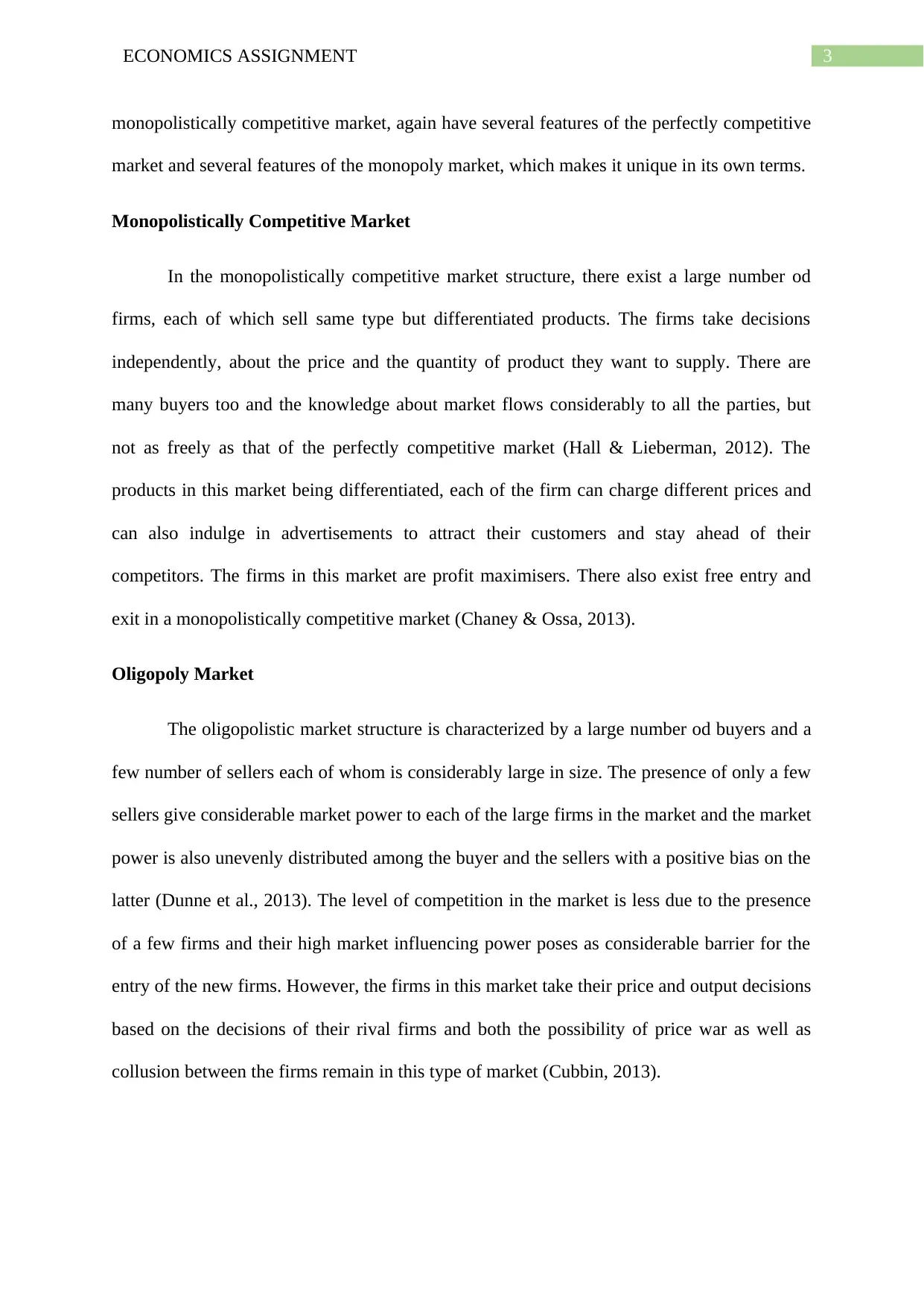
3ECONOMICS ASSIGNMENT
monopolistically competitive market, again have several features of the perfectly competitive
market and several features of the monopoly market, which makes it unique in its own terms.
Monopolistically Competitive Market
In the monopolistically competitive market structure, there exist a large number od
firms, each of which sell same type but differentiated products. The firms take decisions
independently, about the price and the quantity of product they want to supply. There are
many buyers too and the knowledge about market flows considerably to all the parties, but
not as freely as that of the perfectly competitive market (Hall & Lieberman, 2012). The
products in this market being differentiated, each of the firm can charge different prices and
can also indulge in advertisements to attract their customers and stay ahead of their
competitors. The firms in this market are profit maximisers. There also exist free entry and
exit in a monopolistically competitive market (Chaney & Ossa, 2013).
Oligopoly Market
The oligopolistic market structure is characterized by a large number od buyers and a
few number of sellers each of whom is considerably large in size. The presence of only a few
sellers give considerable market power to each of the large firms in the market and the market
power is also unevenly distributed among the buyer and the sellers with a positive bias on the
latter (Dunne et al., 2013). The level of competition in the market is less due to the presence
of a few firms and their high market influencing power poses as considerable barrier for the
entry of the new firms. However, the firms in this market take their price and output decisions
based on the decisions of their rival firms and both the possibility of price war as well as
collusion between the firms remain in this type of market (Cubbin, 2013).
monopolistically competitive market, again have several features of the perfectly competitive
market and several features of the monopoly market, which makes it unique in its own terms.
Monopolistically Competitive Market
In the monopolistically competitive market structure, there exist a large number od
firms, each of which sell same type but differentiated products. The firms take decisions
independently, about the price and the quantity of product they want to supply. There are
many buyers too and the knowledge about market flows considerably to all the parties, but
not as freely as that of the perfectly competitive market (Hall & Lieberman, 2012). The
products in this market being differentiated, each of the firm can charge different prices and
can also indulge in advertisements to attract their customers and stay ahead of their
competitors. The firms in this market are profit maximisers. There also exist free entry and
exit in a monopolistically competitive market (Chaney & Ossa, 2013).
Oligopoly Market
The oligopolistic market structure is characterized by a large number od buyers and a
few number of sellers each of whom is considerably large in size. The presence of only a few
sellers give considerable market power to each of the large firms in the market and the market
power is also unevenly distributed among the buyer and the sellers with a positive bias on the
latter (Dunne et al., 2013). The level of competition in the market is less due to the presence
of a few firms and their high market influencing power poses as considerable barrier for the
entry of the new firms. However, the firms in this market take their price and output decisions
based on the decisions of their rival firms and both the possibility of price war as well as
collusion between the firms remain in this type of market (Cubbin, 2013).
Paraphrase This Document
Need a fresh take? Get an instant paraphrase of this document with our AI Paraphraser
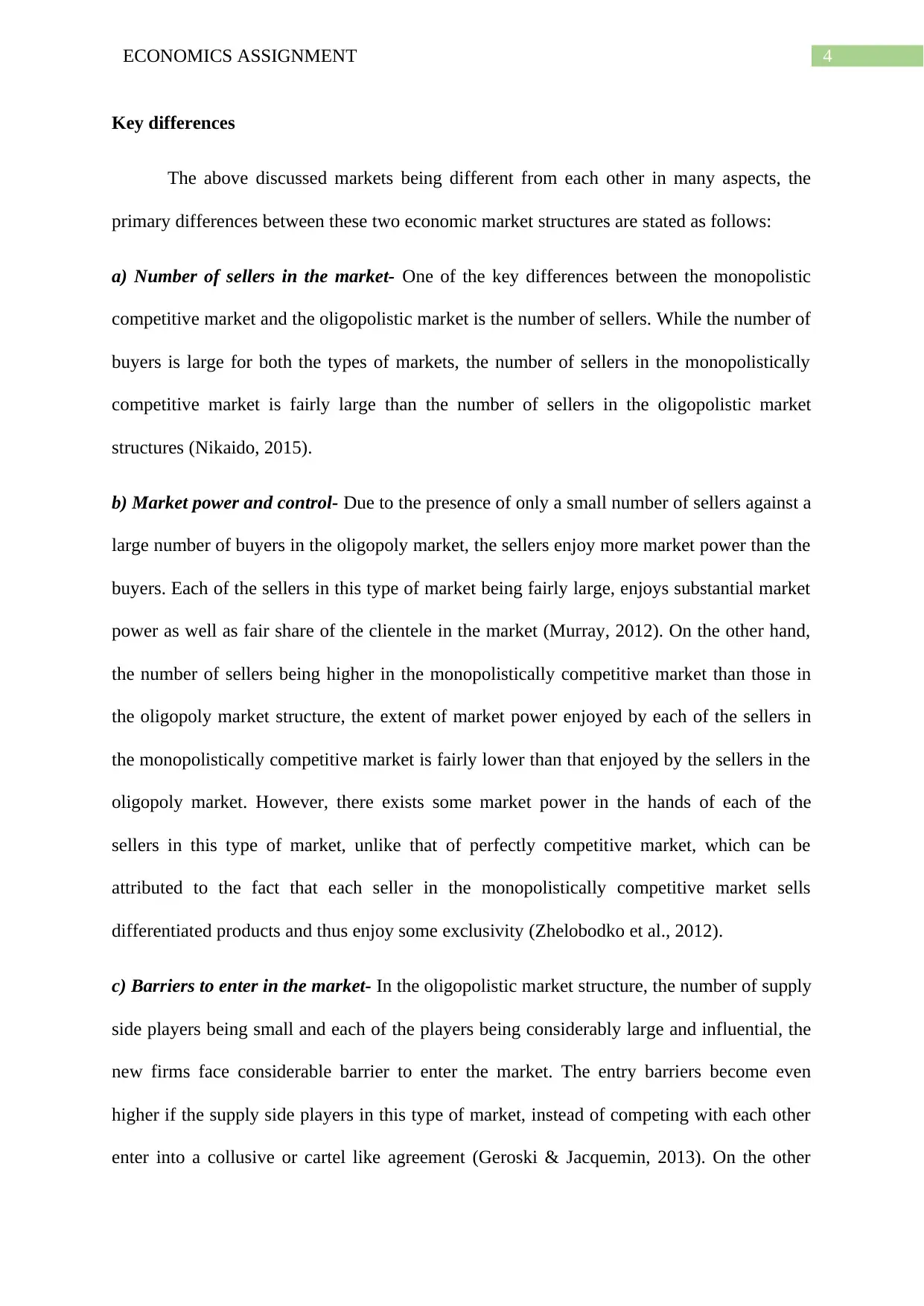
4ECONOMICS ASSIGNMENT
Key differences
The above discussed markets being different from each other in many aspects, the
primary differences between these two economic market structures are stated as follows:
a) Number of sellers in the market- One of the key differences between the monopolistic
competitive market and the oligopolistic market is the number of sellers. While the number of
buyers is large for both the types of markets, the number of sellers in the monopolistically
competitive market is fairly large than the number of sellers in the oligopolistic market
structures (Nikaido, 2015).
b) Market power and control- Due to the presence of only a small number of sellers against a
large number of buyers in the oligopoly market, the sellers enjoy more market power than the
buyers. Each of the sellers in this type of market being fairly large, enjoys substantial market
power as well as fair share of the clientele in the market (Murray, 2012). On the other hand,
the number of sellers being higher in the monopolistically competitive market than those in
the oligopoly market structure, the extent of market power enjoyed by each of the sellers in
the monopolistically competitive market is fairly lower than that enjoyed by the sellers in the
oligopoly market. However, there exists some market power in the hands of each of the
sellers in this type of market, unlike that of perfectly competitive market, which can be
attributed to the fact that each seller in the monopolistically competitive market sells
differentiated products and thus enjoy some exclusivity (Zhelobodko et al., 2012).
c) Barriers to enter in the market- In the oligopolistic market structure, the number of supply
side players being small and each of the players being considerably large and influential, the
new firms face considerable barrier to enter the market. The entry barriers become even
higher if the supply side players in this type of market, instead of competing with each other
enter into a collusive or cartel like agreement (Geroski & Jacquemin, 2013). On the other
Key differences
The above discussed markets being different from each other in many aspects, the
primary differences between these two economic market structures are stated as follows:
a) Number of sellers in the market- One of the key differences between the monopolistic
competitive market and the oligopolistic market is the number of sellers. While the number of
buyers is large for both the types of markets, the number of sellers in the monopolistically
competitive market is fairly large than the number of sellers in the oligopolistic market
structures (Nikaido, 2015).
b) Market power and control- Due to the presence of only a small number of sellers against a
large number of buyers in the oligopoly market, the sellers enjoy more market power than the
buyers. Each of the sellers in this type of market being fairly large, enjoys substantial market
power as well as fair share of the clientele in the market (Murray, 2012). On the other hand,
the number of sellers being higher in the monopolistically competitive market than those in
the oligopoly market structure, the extent of market power enjoyed by each of the sellers in
the monopolistically competitive market is fairly lower than that enjoyed by the sellers in the
oligopoly market. However, there exists some market power in the hands of each of the
sellers in this type of market, unlike that of perfectly competitive market, which can be
attributed to the fact that each seller in the monopolistically competitive market sells
differentiated products and thus enjoy some exclusivity (Zhelobodko et al., 2012).
c) Barriers to enter in the market- In the oligopolistic market structure, the number of supply
side players being small and each of the players being considerably large and influential, the
new firms face considerable barrier to enter the market. The entry barriers become even
higher if the supply side players in this type of market, instead of competing with each other
enter into a collusive or cartel like agreement (Geroski & Jacquemin, 2013). On the other
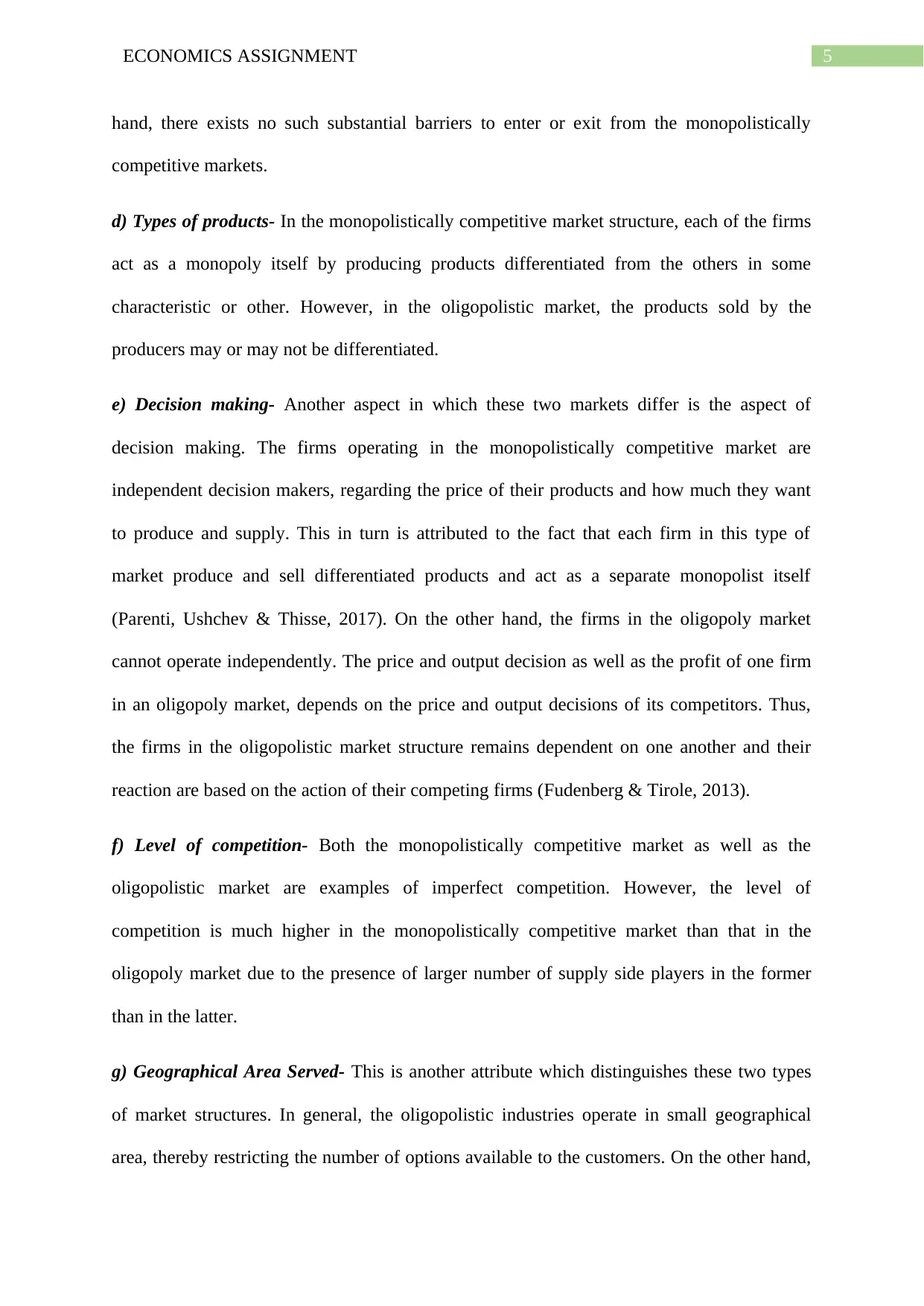
5ECONOMICS ASSIGNMENT
hand, there exists no such substantial barriers to enter or exit from the monopolistically
competitive markets.
d) Types of products- In the monopolistically competitive market structure, each of the firms
act as a monopoly itself by producing products differentiated from the others in some
characteristic or other. However, in the oligopolistic market, the products sold by the
producers may or may not be differentiated.
e) Decision making- Another aspect in which these two markets differ is the aspect of
decision making. The firms operating in the monopolistically competitive market are
independent decision makers, regarding the price of their products and how much they want
to produce and supply. This in turn is attributed to the fact that each firm in this type of
market produce and sell differentiated products and act as a separate monopolist itself
(Parenti, Ushchev & Thisse, 2017). On the other hand, the firms in the oligopoly market
cannot operate independently. The price and output decision as well as the profit of one firm
in an oligopoly market, depends on the price and output decisions of its competitors. Thus,
the firms in the oligopolistic market structure remains dependent on one another and their
reaction are based on the action of their competing firms (Fudenberg & Tirole, 2013).
f) Level of competition- Both the monopolistically competitive market as well as the
oligopolistic market are examples of imperfect competition. However, the level of
competition is much higher in the monopolistically competitive market than that in the
oligopoly market due to the presence of larger number of supply side players in the former
than in the latter.
g) Geographical Area Served- This is another attribute which distinguishes these two types
of market structures. In general, the oligopolistic industries operate in small geographical
area, thereby restricting the number of options available to the customers. On the other hand,
hand, there exists no such substantial barriers to enter or exit from the monopolistically
competitive markets.
d) Types of products- In the monopolistically competitive market structure, each of the firms
act as a monopoly itself by producing products differentiated from the others in some
characteristic or other. However, in the oligopolistic market, the products sold by the
producers may or may not be differentiated.
e) Decision making- Another aspect in which these two markets differ is the aspect of
decision making. The firms operating in the monopolistically competitive market are
independent decision makers, regarding the price of their products and how much they want
to produce and supply. This in turn is attributed to the fact that each firm in this type of
market produce and sell differentiated products and act as a separate monopolist itself
(Parenti, Ushchev & Thisse, 2017). On the other hand, the firms in the oligopoly market
cannot operate independently. The price and output decision as well as the profit of one firm
in an oligopoly market, depends on the price and output decisions of its competitors. Thus,
the firms in the oligopolistic market structure remains dependent on one another and their
reaction are based on the action of their competing firms (Fudenberg & Tirole, 2013).
f) Level of competition- Both the monopolistically competitive market as well as the
oligopolistic market are examples of imperfect competition. However, the level of
competition is much higher in the monopolistically competitive market than that in the
oligopoly market due to the presence of larger number of supply side players in the former
than in the latter.
g) Geographical Area Served- This is another attribute which distinguishes these two types
of market structures. In general, the oligopolistic industries operate in small geographical
area, thereby restricting the number of options available to the customers. On the other hand,
⊘ This is a preview!⊘
Do you want full access?
Subscribe today to unlock all pages.

Trusted by 1+ million students worldwide
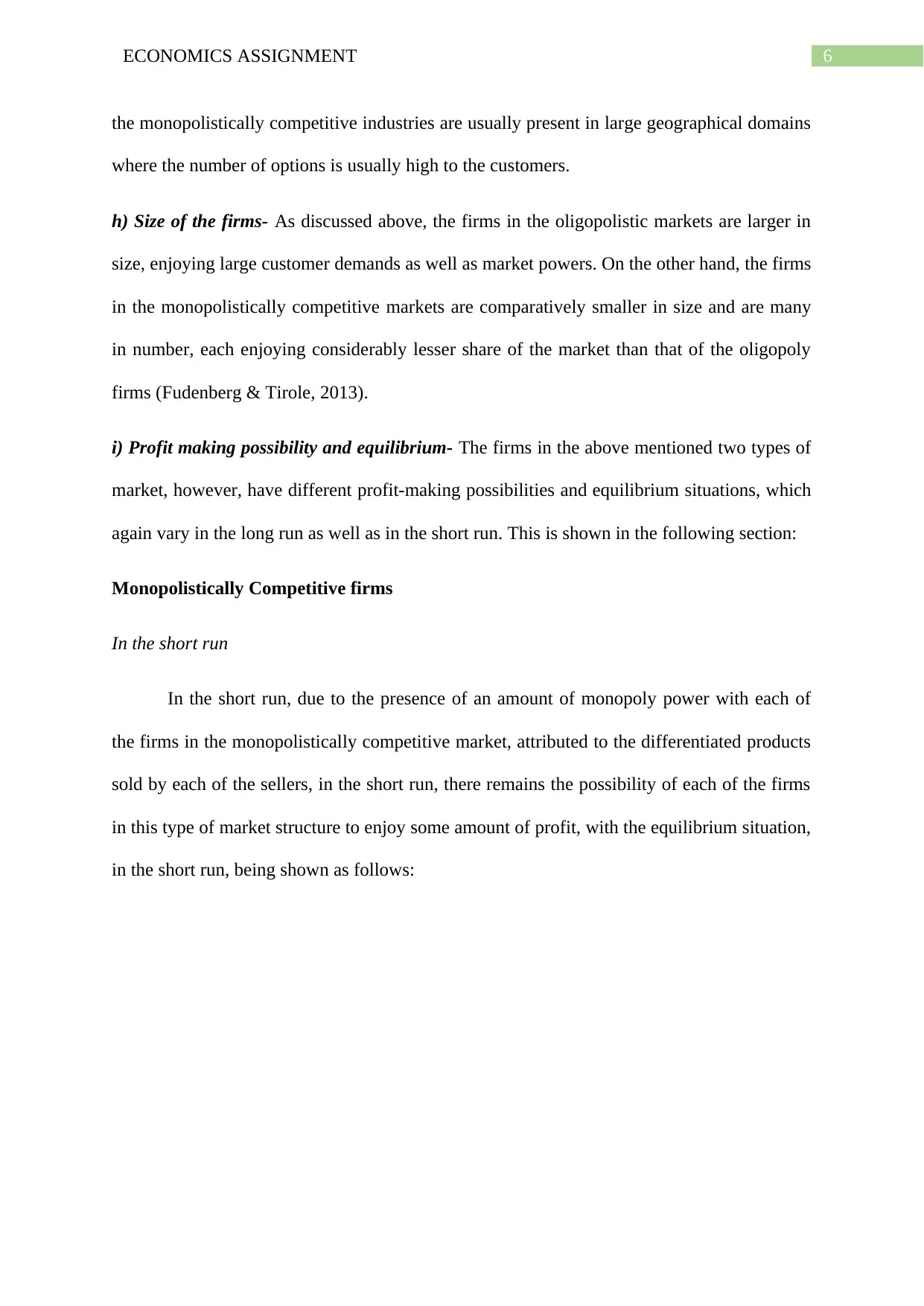
6ECONOMICS ASSIGNMENT
the monopolistically competitive industries are usually present in large geographical domains
where the number of options is usually high to the customers.
h) Size of the firms- As discussed above, the firms in the oligopolistic markets are larger in
size, enjoying large customer demands as well as market powers. On the other hand, the firms
in the monopolistically competitive markets are comparatively smaller in size and are many
in number, each enjoying considerably lesser share of the market than that of the oligopoly
firms (Fudenberg & Tirole, 2013).
i) Profit making possibility and equilibrium- The firms in the above mentioned two types of
market, however, have different profit-making possibilities and equilibrium situations, which
again vary in the long run as well as in the short run. This is shown in the following section:
Monopolistically Competitive firms
In the short run
In the short run, due to the presence of an amount of monopoly power with each of
the firms in the monopolistically competitive market, attributed to the differentiated products
sold by each of the sellers, in the short run, there remains the possibility of each of the firms
in this type of market structure to enjoy some amount of profit, with the equilibrium situation,
in the short run, being shown as follows:
the monopolistically competitive industries are usually present in large geographical domains
where the number of options is usually high to the customers.
h) Size of the firms- As discussed above, the firms in the oligopolistic markets are larger in
size, enjoying large customer demands as well as market powers. On the other hand, the firms
in the monopolistically competitive markets are comparatively smaller in size and are many
in number, each enjoying considerably lesser share of the market than that of the oligopoly
firms (Fudenberg & Tirole, 2013).
i) Profit making possibility and equilibrium- The firms in the above mentioned two types of
market, however, have different profit-making possibilities and equilibrium situations, which
again vary in the long run as well as in the short run. This is shown in the following section:
Monopolistically Competitive firms
In the short run
In the short run, due to the presence of an amount of monopoly power with each of
the firms in the monopolistically competitive market, attributed to the differentiated products
sold by each of the sellers, in the short run, there remains the possibility of each of the firms
in this type of market structure to enjoy some amount of profit, with the equilibrium situation,
in the short run, being shown as follows:
Paraphrase This Document
Need a fresh take? Get an instant paraphrase of this document with our AI Paraphraser
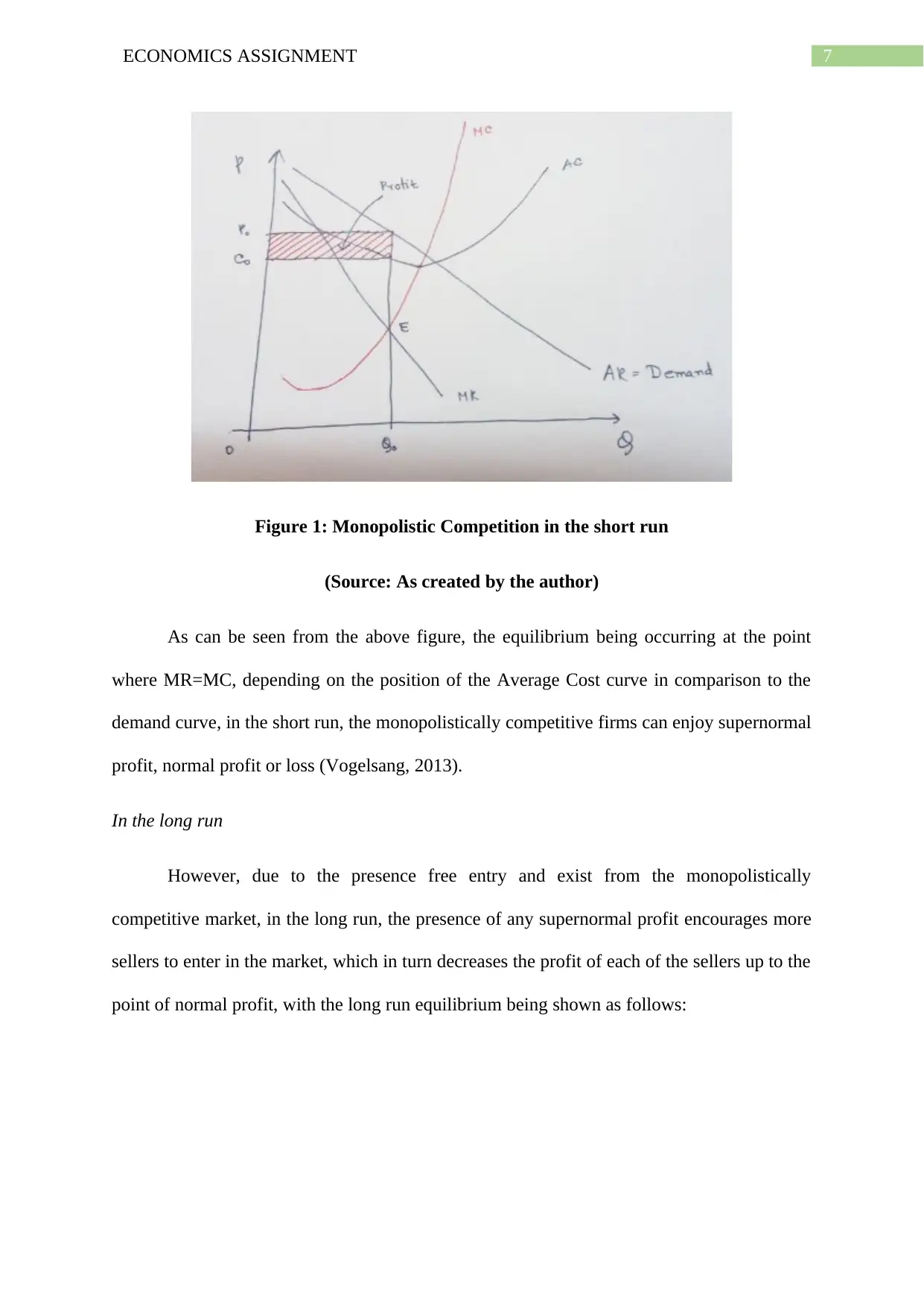
7ECONOMICS ASSIGNMENT
Figure 1: Monopolistic Competition in the short run
(Source: As created by the author)
As can be seen from the above figure, the equilibrium being occurring at the point
where MR=MC, depending on the position of the Average Cost curve in comparison to the
demand curve, in the short run, the monopolistically competitive firms can enjoy supernormal
profit, normal profit or loss (Vogelsang, 2013).
In the long run
However, due to the presence free entry and exist from the monopolistically
competitive market, in the long run, the presence of any supernormal profit encourages more
sellers to enter in the market, which in turn decreases the profit of each of the sellers up to the
point of normal profit, with the long run equilibrium being shown as follows:
Figure 1: Monopolistic Competition in the short run
(Source: As created by the author)
As can be seen from the above figure, the equilibrium being occurring at the point
where MR=MC, depending on the position of the Average Cost curve in comparison to the
demand curve, in the short run, the monopolistically competitive firms can enjoy supernormal
profit, normal profit or loss (Vogelsang, 2013).
In the long run
However, due to the presence free entry and exist from the monopolistically
competitive market, in the long run, the presence of any supernormal profit encourages more
sellers to enter in the market, which in turn decreases the profit of each of the sellers up to the
point of normal profit, with the long run equilibrium being shown as follows:
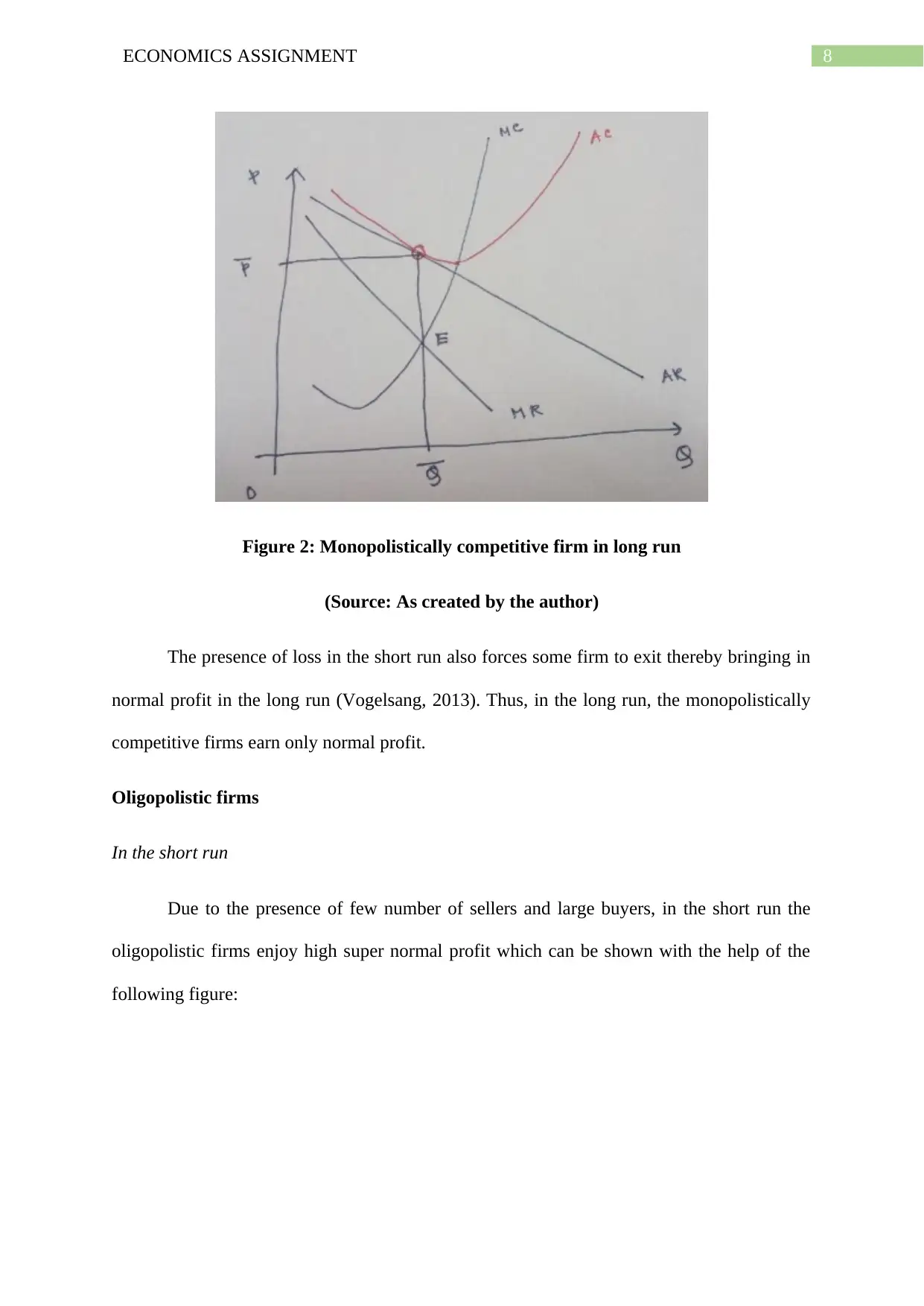
8ECONOMICS ASSIGNMENT
Figure 2: Monopolistically competitive firm in long run
(Source: As created by the author)
The presence of loss in the short run also forces some firm to exit thereby bringing in
normal profit in the long run (Vogelsang, 2013). Thus, in the long run, the monopolistically
competitive firms earn only normal profit.
Oligopolistic firms
In the short run
Due to the presence of few number of sellers and large buyers, in the short run the
oligopolistic firms enjoy high super normal profit which can be shown with the help of the
following figure:
Figure 2: Monopolistically competitive firm in long run
(Source: As created by the author)
The presence of loss in the short run also forces some firm to exit thereby bringing in
normal profit in the long run (Vogelsang, 2013). Thus, in the long run, the monopolistically
competitive firms earn only normal profit.
Oligopolistic firms
In the short run
Due to the presence of few number of sellers and large buyers, in the short run the
oligopolistic firms enjoy high super normal profit which can be shown with the help of the
following figure:
⊘ This is a preview!⊘
Do you want full access?
Subscribe today to unlock all pages.

Trusted by 1+ million students worldwide
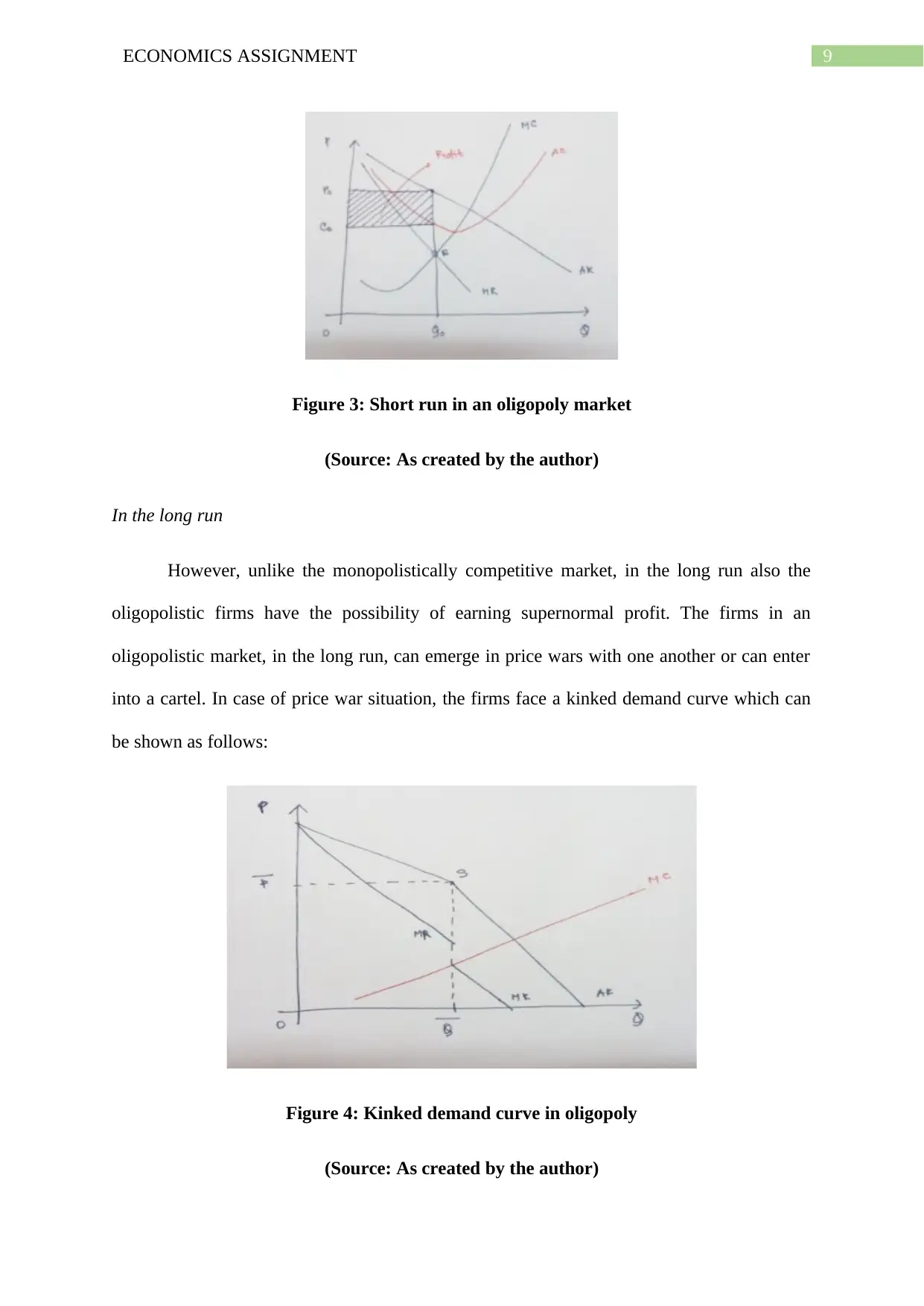
9ECONOMICS ASSIGNMENT
Figure 3: Short run in an oligopoly market
(Source: As created by the author)
In the long run
However, unlike the monopolistically competitive market, in the long run also the
oligopolistic firms have the possibility of earning supernormal profit. The firms in an
oligopolistic market, in the long run, can emerge in price wars with one another or can enter
into a cartel. In case of price war situation, the firms face a kinked demand curve which can
be shown as follows:
Figure 4: Kinked demand curve in oligopoly
(Source: As created by the author)
Figure 3: Short run in an oligopoly market
(Source: As created by the author)
In the long run
However, unlike the monopolistically competitive market, in the long run also the
oligopolistic firms have the possibility of earning supernormal profit. The firms in an
oligopolistic market, in the long run, can emerge in price wars with one another or can enter
into a cartel. In case of price war situation, the firms face a kinked demand curve which can
be shown as follows:
Figure 4: Kinked demand curve in oligopoly
(Source: As created by the author)
Paraphrase This Document
Need a fresh take? Get an instant paraphrase of this document with our AI Paraphraser
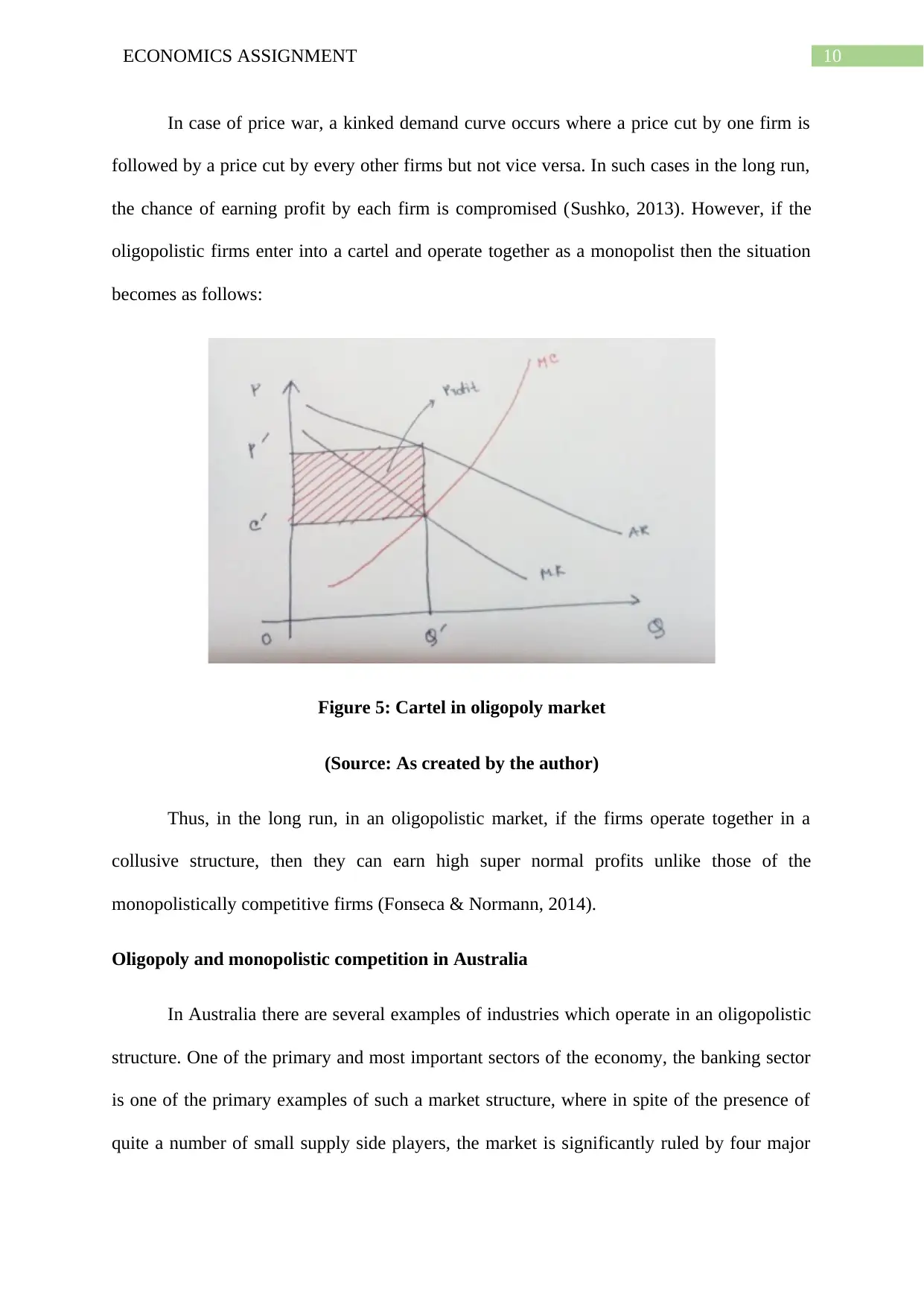
10ECONOMICS ASSIGNMENT
In case of price war, a kinked demand curve occurs where a price cut by one firm is
followed by a price cut by every other firms but not vice versa. In such cases in the long run,
the chance of earning profit by each firm is compromised (Sushko, 2013). However, if the
oligopolistic firms enter into a cartel and operate together as a monopolist then the situation
becomes as follows:
Figure 5: Cartel in oligopoly market
(Source: As created by the author)
Thus, in the long run, in an oligopolistic market, if the firms operate together in a
collusive structure, then they can earn high super normal profits unlike those of the
monopolistically competitive firms (Fonseca & Normann, 2014).
Oligopoly and monopolistic competition in Australia
In Australia there are several examples of industries which operate in an oligopolistic
structure. One of the primary and most important sectors of the economy, the banking sector
is one of the primary examples of such a market structure, where in spite of the presence of
quite a number of small supply side players, the market is significantly ruled by four major
In case of price war, a kinked demand curve occurs where a price cut by one firm is
followed by a price cut by every other firms but not vice versa. In such cases in the long run,
the chance of earning profit by each firm is compromised (Sushko, 2013). However, if the
oligopolistic firms enter into a cartel and operate together as a monopolist then the situation
becomes as follows:
Figure 5: Cartel in oligopoly market
(Source: As created by the author)
Thus, in the long run, in an oligopolistic market, if the firms operate together in a
collusive structure, then they can earn high super normal profits unlike those of the
monopolistically competitive firms (Fonseca & Normann, 2014).
Oligopoly and monopolistic competition in Australia
In Australia there are several examples of industries which operate in an oligopolistic
structure. One of the primary and most important sectors of the economy, the banking sector
is one of the primary examples of such a market structure, where in spite of the presence of
quite a number of small supply side players, the market is significantly ruled by four major
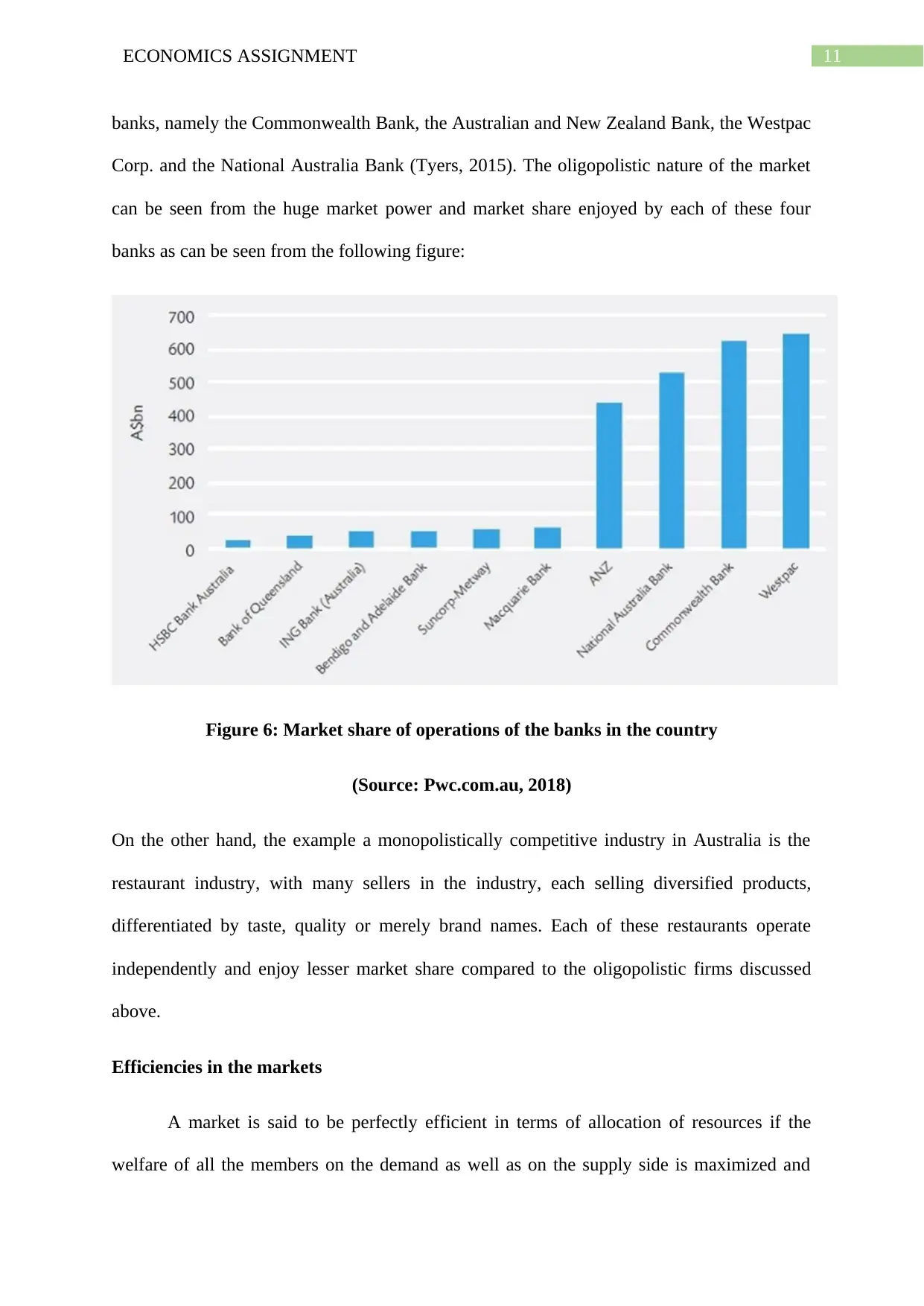
11ECONOMICS ASSIGNMENT
banks, namely the Commonwealth Bank, the Australian and New Zealand Bank, the Westpac
Corp. and the National Australia Bank (Tyers, 2015). The oligopolistic nature of the market
can be seen from the huge market power and market share enjoyed by each of these four
banks as can be seen from the following figure:
Figure 6: Market share of operations of the banks in the country
(Source: Pwc.com.au, 2018)
On the other hand, the example a monopolistically competitive industry in Australia is the
restaurant industry, with many sellers in the industry, each selling diversified products,
differentiated by taste, quality or merely brand names. Each of these restaurants operate
independently and enjoy lesser market share compared to the oligopolistic firms discussed
above.
Efficiencies in the markets
A market is said to be perfectly efficient in terms of allocation of resources if the
welfare of all the members on the demand as well as on the supply side is maximized and
banks, namely the Commonwealth Bank, the Australian and New Zealand Bank, the Westpac
Corp. and the National Australia Bank (Tyers, 2015). The oligopolistic nature of the market
can be seen from the huge market power and market share enjoyed by each of these four
banks as can be seen from the following figure:
Figure 6: Market share of operations of the banks in the country
(Source: Pwc.com.au, 2018)
On the other hand, the example a monopolistically competitive industry in Australia is the
restaurant industry, with many sellers in the industry, each selling diversified products,
differentiated by taste, quality or merely brand names. Each of these restaurants operate
independently and enjoy lesser market share compared to the oligopolistic firms discussed
above.
Efficiencies in the markets
A market is said to be perfectly efficient in terms of allocation of resources if the
welfare of all the members on the demand as well as on the supply side is maximized and
⊘ This is a preview!⊘
Do you want full access?
Subscribe today to unlock all pages.

Trusted by 1+ million students worldwide
1 out of 20
Related Documents
Your All-in-One AI-Powered Toolkit for Academic Success.
+13062052269
info@desklib.com
Available 24*7 on WhatsApp / Email
![[object Object]](/_next/static/media/star-bottom.7253800d.svg)
Unlock your academic potential
Copyright © 2020–2025 A2Z Services. All Rights Reserved. Developed and managed by ZUCOL.





